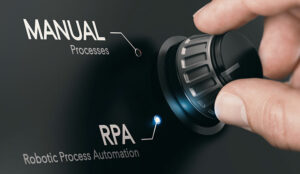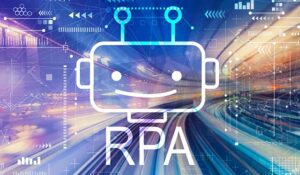Businesses across all industries are turning to the power of automation as they look to minimize costs while maximizing efficiency.
Traditionally, to deploy automation, organizations had to use high-code applications that required expert programmers.
But no-code robotic process automation (RPA) is changing the game, enabling any user to implement bots without having any knowledge of the underlying technology infrastructure.
Combined with conversational artificial intelligence (AI), RPA enables companies to better understand their customers’ needs and offer seamless customer support and more engaging interactions.
What Is Robotic Process Automation (RPA)?
RPA is the use of software robots, also known as bots, that learn, imitate and then automatically execute rules-based business processes. It combines application program interfaces (APIs) and user interfaces to emulate human functions on enterprise and productivity programs.
Users can deploy robotic automation to carry out basic tasks that are tedious to complete manually, such as extracting data from systems, completing forms or moving files between databases. This RPA enables users to show bots what they want them to do, and the bot will precisely and reliably repeat it.
How Does RPA Work?
RPA automation uses a rule-based software process to rapidly perform basic tasks at a high volume. Bots need to have the low-code (or no-code) capability to develop, configure and monitor automation scripts and integrate with enterprise applications.
As a result, RPA bots can access information from applications and legacy systems to complete tasks in the same way as human employees.
How RPA Differs From Traditional Automation
The automation of enterprise tasks has existed for decades. But the introduction of RPA is helping businesses to reduce costs, time and human effort while increasing accuracy, productivity and quality of work. The main differences between the RPA definition and traditional automation include:
Actions:
The most significant difference between traditional automation and RPA is the core processes they can complete.
Traditional automation systems execute tasks based on the predefined instructions they’re provided. But RPA is more like a virtual assistant, which can learn and mimic human actions to perform functions like a human would in the same situation.
Complexity:
With traditional automation, developers needed to deeply understand the infrastructure and technology stack, user behavior and the steps required to create an automation project, integrate it and continuously customize it.
Whereas RPA requires minimal technical understanding and uses a rules-based process to carry out high volumes of tasks without any human involvement.
Deployment Time:
A traditional automation project can take months to implement as it requires time-consuming designing and testing.
RPA uses graphical user interfaces (GUIs), which means it can be deployed across a system without having to be integrated. It’s therefore quicker and easier to implement RPA across an organization and scale it up or down as resources demand.
Speed:
RPA uses software bots to gain an understanding of user actions and behavior and seamlessly integrate automation across existing systems and infrastructure.
RPA bots sit on top of existing systems, which makes the process quicker, more efficient and transferable across different systems.
The Difference Between RPA and AI
It can be easy to mistake RPA for AI, but the two have clear and distinct differences. The main defining feature is that AI is driven by data to simulate human intelligence, whereas RPA is driven by processes to mimic human actions.
AI combines technologies, tools and processes like automation, machine learning and natural language processing. This enables AI systems to spot patterns in data and develop their understanding over time. Whereas RPA bots follow the processes that users define.
That said, AI and RPA are highly compatible. AI systems can help RPA bots to complete more complex tasks and enhance their automation capacity. RPA bots can enable businesses to act quickly on their AI insights, rather than waiting on people to manually implement them.
What Are the Benefits of Implementing RPA?
Implementing RPA offers a wide range of benefits for enterprises to reduce costs and increase efficiency, including:
Improved Employee Experience
Implementing RPA does not mean that robots are replacing humans. Instead, RPA removes menial tasks from users’ to-do lists, freeing them up to focus on more demanding jobs that offer greater value to the business.
As a result, people feel more valued by their employers and are more likely to enjoy their work as they take on more challenging tasks.
High Reliability
RPA bots aren’t affected by tiredness or being overworked, so they can simply repeat tasks endlessly. You can therefore guarantee repetitive tasks will be completed automatically and successfully, without concerns about human error.
Low Technical Barrier
RPA bots can easily adapt to any interface or workflow without being integrated or learning its processes. They’re therefore easy to deploy and don’t require any changes to applications, business systems or existing approaches to begin automating tasks.
Speed, Accuracy and Compliance
RPA automation can perform high volumes of basic business processes at high speed. As a result, it can perform more tasks than a human could possibly manage and with guaranteed accuracy.
Furthermore, bots don’t get tired or need to take breaks or vacations, so they can rapidly perform menial tasks at any time without risking human error.
The use of rule-based software means RPA bots can follow specific instructions and workflows, which is critical to complying with increasingly stringent regulatory standards.
They can also provide clear audit trails, which allows you to monitor the bots’ progress and resolve potential issues more quickly.
Customer Satisfaction
RPA bots’ ability to work around the clock with minimal human interaction can bolster your customer service offering. You can task RPA bots to identify complaints, update customer details, scan the web for reviews and more processes that are time-intensive for customer service representatives.
You can also integrate RPA with chatbots to manage auto-responses to customers and use it to monitor for issues across your customer service infrastructure.
Where Is RPA Being Used?
Implementing RPA effectively means deploying a digital workforce to carry out processes across any application or system. RPA bots can connect to APIs and log into applications to copy and paste data or files, scrape the web for information, perform calculations, extract unstructured data and much more.
RPA is used to carry out any task that’s easy to create, set up and repeat. For example, you could teach RPA bots how to take a photo on a phone, then configure and schedule them to take multiple pictures and store them in a specific location.
Therefore, the robot automation process can benefit any business that relies on repeatable processes to streamline operations. But RPA is widely used across industries like:
Financial Services:
The financial services market is one of the biggest proponents of RPA, with Forrester research revealing one in three bots are deployed by the industry.
Banks use RPA bots to automate tasks like opening an account, checking account statuses, initiating customer research and preventing money laundering. Banks deploy thousands of bots to automate high-volume data entry tasks that would be tedious for humans to complete manually.
Healthcare:
Healthcare services are highly reliant on accurate data and compliance. So, hospitals and other health firms use RPA bots to manage prescriptions and post-discharge actions, process claims, schedule appointments, maintain consistent care provision and manage staffing issues.
Insurance:
The speed and accuracy of RPA bots are vital to carrying out repetitive processes across the insurance industry. This includes creating policies, processing claims, collecting deposits, verifying customers, managing regulatory compliance requirements and completing underwriting tasks.
Manufacturing:
Companies across the manufacturing industry rely heavily on automation processes to streamline their factory lines. They’re also heavy proponents of RPA bots, which help them carry out repetitive tasks like managing inventory, complying with regulatory requirements, verifying invoices, enhancing customer service and processing order purchases.
Retail:
RPA is crucial to the eCommerce world, helping businesses to enhance their back-office operations and transform the customer experience. RPA bots are frequently used to manage customer relationships, forecast customer demands, manage warehouse orders and inventory flow, issue stock shortage alerts, process customer feedback and detect potentially fraudulent activity.
Telecoms:
The telecoms industry uses RPA bots to streamline its customer service operations. Telecom firms regularly utilize RPA to process unstructured data like invoices into readable information, update databases, perform data extraction, prevent data duplication and errors, monitor network traffic for downtime, detect security threats, enhance customer self-service capabilities and boost first call resolution.
Integrating RPA Into the Workplace the Right Way
Before going ahead and implementing RPA into your enterprise, it’s crucial to consider the right way to integrate it.
This begins with identifying how RPA will fit into your business approach, the purpose you want it to achieve and how it will evolve the role of your human employees. Factors to build into this include:
Identifying Processes to Automate
How you implement and integrate RPA into your workforce will depend heavily on the industry you operate in and the benefits you want to achieve.
It’s therefore vital to identify which existing business processes would benefit most from being automated. Furthermore, consider how adding any RPA bot aligns with and delivers on your overall business vision.
Selecting the Right Tools
Your RPA tool must be able to identify errors more quickly than is possible through manual detection. It must also offer great visibility, notify people of pending actions and provide other control and monitoring features.
Building and Testing the RPA Solution
Before launching an RPA solution, the system must be thoroughly tested and tweaked. You need to ensure it reliably performs tasks to the highest quality and is adaptable across your various applications and systems.
Testing your RPA tool against your requirements can help transform complex and challenging tasks into efficient, effective and highly repeatable processes.
Measuring the Success of Implementation
As with any project you roll out, you need to have some idea of success in mind before launching an RPA project. Take time to monitor the value that the project is delivering and regularly assess its success in line with your initial objectives.
Considering Human Roles
The role of people has to be central to any potential RPA implementation. RPA is not intended to replace humans, but rather to enhance their productivity and make them more efficient.
RPA frees up your employees to work on tasks that deliver greater value to the business and require more creativity, critical thinking and sensitivity.
Furthermore, any new process requires some human involvement to oversee the implementation, maintenance and management of the project. So, it’s important to consider how people fit into all RPA projects and clearly define the value of people within them.
Security Considerations
RPA bots can handle private data, such as customer details or patient information, so ensure you have security measures in place to protect it and prevent it from being leaked. Having the right security tools will also protect your system against malicious attacks, data misuse and privacy issues.
Prepare Your Business for the Future of Work With RPA
RPA bots are transforming businesses across all industries, helping them automate mundane but time-intense tasks to help employees become more efficient and valuable.
Pairing RPA with AI is critical to unlocking the technology’s full potential. Combined with AI and machine learning, RPA bots can be configured to automate decision-making processes and help businesses bring data-driven intelligence into their daily operation
Author: Guest Author
Published On: 21st Jul 2023 - Last modified: 9th Dec 2024
Read more about - Guest Blogs, Uniphore















